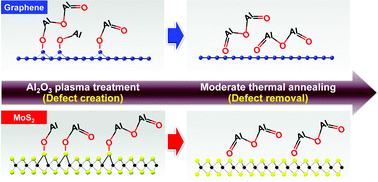Controlled defect creation and removal in graphene and MoS2 monolayers†
Abstract
It is known that defects strongly influence the properties of two-dimensional (2D) materials. The controlled creation and removal of defects can be utilized to tailor the optical and electronic responses of these 2D materials for optoelectronic and nanoelectronic applications. In this study, we developed an efficient approach to reversibly control the defect states in mechanically exfoliated graphene and molybdenum disulfide (MoS2) monolayers. The defects were created by aluminium oxide (Al2O3) plasmas and removed by moderate thermal annealing at up to 300 °C. We employed Raman and photoluminescence (PL) as well as electrical characterization to monitor the variation of the defect level in graphene and MoS2. For graphene, Raman spectra indicate that the Al2O3 plasma induced sp3-type defects with a controlled concentration, which have been substantially removed after thermal annealing. A similar trend was also observed in monolayer MoS2, as revealed by the defect-related emission peak (Xb) in the PL spectra. We further showed that the defects induced by the Al2O3 plasma in both 2D materials can be restored to any intended level via annealing under well-controlled conditions. Our work presents a new route to the functional design of the optical and electronic properties of graphene and MoS2-based devices through defect engineering.



 Please wait while we load your content...
Please wait while we load your content...